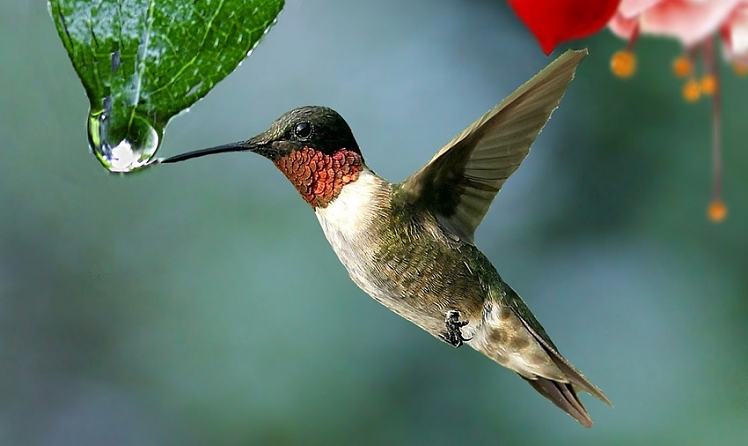Throughout the warmer months, many backyards play host to a variety of birds, including hummingbirds. When you see flowers and trees begin to bud and bloom and other migrating birds, like warblers, that’s nature’s way of letting you know it’s time to ready your yard for hummingbirds.
It’s enchanting watching hummingbirds – named for the humming sound of their fast-flapping wings – as their tiny size and speed make them natural wonders. Hummingbirds can fly 25-30 miles per hour, flapping their wings an estimated 70 times per second. They fly in every direction, even backward, which only hummers can do, and float majestically in midair.

The birds get their brilliant color from the iridescence in the arrangement of their feathers, not color pigment. Plus, they have the fastest metabolism of any animal on Earth, burning 1-2 times their body weight in food daily. Hummingbirds draw nectar from its source into their mouths, lapping it up almost 12 times per second.
To increase your chances of observing these petite powerhouses at home, consider these tips from the experts at Cole’s Wild Bird Products:
Be conscious of beneficial insects. Hummingbirds rely on insects, which provide essential protein, to complement the nectar they crave. To attract insects, try placing rotting fruit near feeders and leave it until insects arrive for hummers’ easy eats.
Leave spiderwebs alone: Hummingbirds use spiderwebs as construction material to hold their nests together and pluck insects caught in the webbing.
Offer a water mister: Hummingbirds adore bathing; a mister gives them the fine spray they prefer. Once soaked, they’re off to find a preening perch.
Provide tiny perches. Leave small, sturdy, bare branches for hummingbirds, to perch on for rest, preening and hunting. Perches provide vantage points to see danger and launching pads to swiftly pounce on insects. Once hummingbirds find a favorite perch, they’ll use it repeatedly.
Hang hummingbird feeders first. Feeders are one of the most effective ways to consistently entice and encourage hummingbirds to come visit. However, not all feeders are created equal. For example, Cole’s Hummer High Rise Feeder is scientifically designed with elevated perches to make hummingbirds feel safe and comfortable, which encourages their consistent return.
Although hummingbird feeders can attract bees and ants, this feeder is uniquely designed to keep pests at bay. It doesn’t drip, so large bees can’t get to the nectar, plus it has a built-in ant moat to keep ants away from nectar when filled with plain water. Since birds drink from the moat, never use any repellents or additives.
Hummingbirds are territorial and not likely to share feeders, so hang multiple feeders far enough apart to attract more birds. To ensure a steady stream of birds, hang feeders in the shade to avoid fermentation of sugar-based liquids, check feeders bi-weekly to keep food fresh and clean feeders as needed with one part white vinegar to four parts water.
Plant flowers. Trumpet honeysuckle, bee balm and sage plants are particularly attractive to hummingbirds and provide rich nectar. Hummingbirds consume 1 1/2 times their body weight daily, eating every 10-15 minutes and visiting 1,000-2,000 flowers per day.
Choose the right nectar. Not all nectar is alike, and hummingbirds can taste the difference. Almost all commercial nectars contain one sugar source – sucrose – because it’s cheaper to make. However, real flower nectar contains three sugar sources – sucrose, fructose and glucose – in varying amounts depending on the flower.
Researched and designed to attract the greatest variety of hummingbirds, Cole’s Nature’s Garden is a high energy, nutrient-rich nectar that combines all three types of organically sourced sugars North American hummingbirds love, with a spring water base. It closely mimics the sugar ratios they favor and provides a healthier, nutritious, all-natural alternative to table sugar.
Don’t forget, hummingbirds have memories like elephants; once they discover your hummer-friendly habitat, they’ll come back every year if there’s a reliable food source. Learn more at coleswildbird.com.
SOURCE:
Cole’s Wild Bird Products (Family Features) (LRS) (Willamette Valley Magazine)

